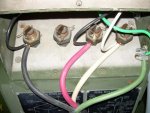- 4,640
- 30
- 38
- Location
- Cambridge, Ohio
BC
The situation you are describing is what the NEC would deem to be a "Non Separately Derived System" (Non SDS) installation. In your case what you would want to do is this.
1) At the genset ground lug, disconnect the short wire coming from the plug on the back of the AC reconnection box from the grounding lug and tape it off. (This wire is your L0, Isolate it from ground)
2) Use your 4 wire cable just as you described above...hot wires to the breakers, neutral to neutral buss and connect the ground to the genset and the grounding location from your utility feed.
That's the safe way to do it according to the NEC. Read this thread...MEP-003a hook up question. It has a lot of information and even a few pictures of what I'm talking about with the Non SDS and why you want to isolate the ground and neutral from your genset.
The only problem with this type of installation is, if you ever want to use your genset as a stand-alone power source to power a welder or remote shop or something like that, then you'll have to hook up the L0 again and drive a ground rod to be able to use it safely.
The situation you are describing is what the NEC would deem to be a "Non Separately Derived System" (Non SDS) installation. In your case what you would want to do is this.
1) At the genset ground lug, disconnect the short wire coming from the plug on the back of the AC reconnection box from the grounding lug and tape it off. (This wire is your L0, Isolate it from ground)
2) Use your 4 wire cable just as you described above...hot wires to the breakers, neutral to neutral buss and connect the ground to the genset and the grounding location from your utility feed.
That's the safe way to do it according to the NEC. Read this thread...MEP-003a hook up question. It has a lot of information and even a few pictures of what I'm talking about with the Non SDS and why you want to isolate the ground and neutral from your genset.
The only problem with this type of installation is, if you ever want to use your genset as a stand-alone power source to power a welder or remote shop or something like that, then you'll have to hook up the L0 again and drive a ground rod to be able to use it safely.
Last edited:





